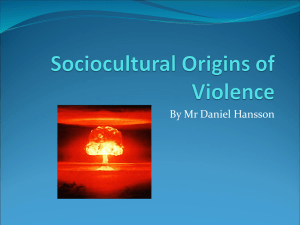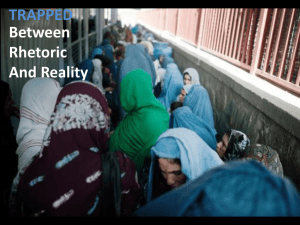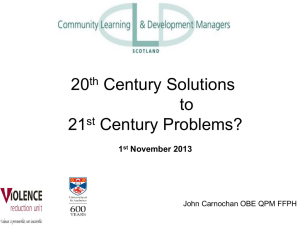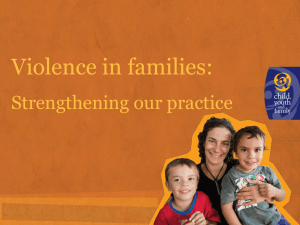Chapter 10 Study Questions
advertisement
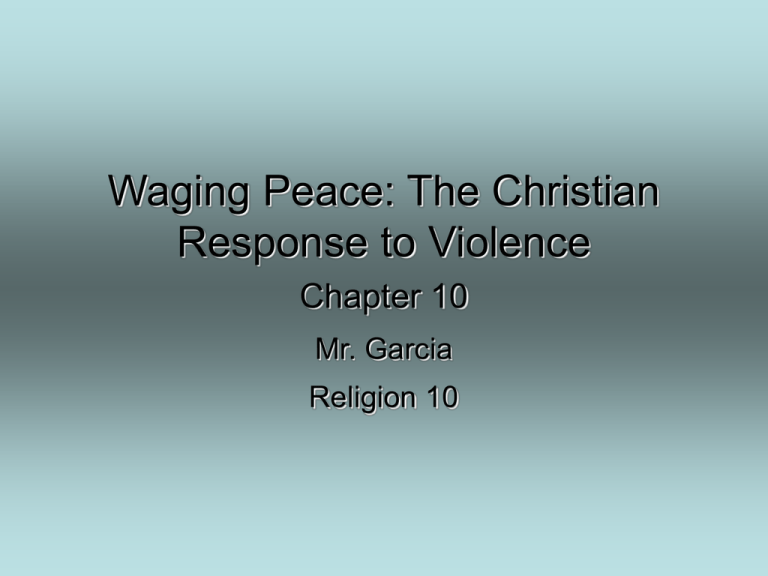
Waging Peace: The Christian Response to Violence Chapter 10 Mr. Garcia Religion 10 1. How does conventional wisdom suggest we respond to violence, and why? How does Christianity suggest we respond to violence, and why? Conventional wisdom suggests that violence is the way to respond to violence; the strongest party will be the one to win flight. Christianity claims that love, not violence, brings true order and peace to the world. It bases this claim on the belief that although Christ was crucified and died, the life-giving power of his Father’s love overcame that violence in Christ’s Resurrection. 2. What types of power are illustrated in Paolo’s story? You may find it helpful to review the discussion of power in chapter 3. 3. How does Paolo’s story reflect the principles of nonviolent noncooperation discussed in chapter 3? Use specific examples from the story to support your answer. 4. Define the following terms: violence, institutional violence, deterrence, arm race. • Violence is any human action that causes harm to the life or dignity of another person. • Institutional violence is the sort of violence that occurs as a result of unjust social structures rather than as a direct result of one person’s actions. • Deterrence is the theory that the potential of one country to inflict significant harm on its adversaries will deter, or discourage, those adversaries from attacking it first. • The arms race is the competition between rival nations to have the biggest and best military force. 5. Describe the spiral of violence. At the root of the spiral of violence is a conflict that has been resolved by some people of others, thus creating a basic injustice. This injustice prompts a violent response by those people injured by the injustice. Those causing the initial injustice then make a violent counterresponse. Violence escalate as each side attempts to defeat the other with the use of greater force. In the end, if the “winner” imposes its will on the “loser” in a way that is unjust, the spiral may begin all over again. 6. What are two significant cause of youth violence? The breakdown of relationships and the influence of a culture of violence. 7. Name two consequence of the arms race. More violence and less money for poor and vulnerable people. 8. What two options do most people see for responding to violence? What is a third option taught by Jesus? Most people think that submitting to violence or responding with violence are the only options people have when faced with a violence situation. Jesus taught that only love can break the spiral of violence. 9. Explain the logic of violent retaliation and why the church regards that logic as flawed. 10. Define peace. What are two prerequisities of peace? Peace is the harmony that results when people resolve conflicts by working in love for the good of all. Peace is the result of both justice and love. 11. How is Jesus’ cross the source of all grace? By the blood of his cross, Jesus killed the hostility that separates people from one another and God. He responded to those who crucified him not with more violence but with forgiveness. By refusing to retaliate, he broke the spiral of violence. And by following God’s way of love even in the face of death, he liberated humanity from sin, the root cause of all violence. 12. What is the role does grace play in the Christian response to violence? We need God’s help to choose peace, but if we are open to the grace provided by the Holy Spirit, we are able to go beyond ourselves to accomplish what we thought was impossible. 13. Describe pacifism and just-war theory. How are they the same, and how are they differ? Pacifism is the opposition to the use of violence to resolve conflict. Justwar theory also opposes the use of violence, but it presumes that loves calls Christian to restrain any enemy who would harm innocent people, and so allows for limited violence if other peaceful options have been exhausted. The purpose of just-war theory is not to encourage war but first to prevent it and then to limit it as much as possible. 14. What type of war does the church say is never justified? Total warfare, in which there is indiscrimination destruction of wholes cities or vast areas along with the inhabitants. 15. What rights and obligations does the church say people should consider when deciding whether and how to participate in war? Nations have the right to legitimate self-defense once all other peaceful alternatives have been exhausted. Individuals have the right to refuse to fight for reasons of conscience. Those who refuse to fight for the sake of peace are still obliged to seek justice and those who wage just war are obligated to always seek peace . 16. Suppose a nation is considering going to war. What question does the church say should be asked to determine whether going to war is justified? What questions should be asked during the war itself? 17. List the five suggested ways of waging peace one person at a time, briefly explaining how each promotes peace. • Promoting justice stop violence. When people promote personal responsibility, respect for human life and human dignity, and a recommitment to social justice, they take the path to a more peaceful future. • Solidarity builds relationships. When people know one another, they are less likely to commit violence against one another. • Nonviolence protests help create a culture of peace. By confronting and nonviolence opposing those committing violence, peacemakers call others to do the same through their words and example. • Nonviolence non-cooperation can surprise an attacker who expects a victim to respond either violently or helplessly. • Reconciliation promotes peace by mending broken relationships. 18. How can demilitarization lessens the temptation to wage war and frees resources for other social needs. 19. Explain the principle of reciprocity. Reciprocity means that each side holds itself to the same standards that it wishes to impose on to other nations. 20. What are some of the tools of nonviolence non-cooperation, and what is required for it to be most successful? Boycotts, strikes, and mass civil disobedience are some tools. Training makes nonviolence non-cooperation successful. 21. Based on what you have learned in this chapter, how do you think peace between individual people and peace on a global level are interrelated?



